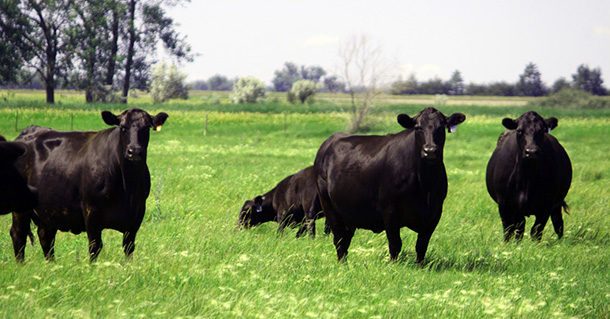Seasonal marketing
Seasonality has an influence on the price of slaughter cows. During the fall months, when most producers are weaning calves and pregnancy checking cows, many cows are placed on the market, thereby resulting in a price slump. Historically, months that have fewer cows available exhibit higher prices paid for slaughter cows. The following graph reflects the seasonal changes in cow prices.

Market timing can be used as a major factor in designing a cull cow management program. At the 2017 Range Beef Cow Symposium, speakers indicated that in 23 of the last 25 years, the seasonality of cull cow prices followed the same pattern. By beginning with the end in mind (the month of marketing) and working back in time, operations can plan nutritional and management programs that will maximize profits.
Nutritional considerations
Cows, especially thin, healthy cows, have tremendously large appetites. David Lalman and Chris Richards (2017), beef cattle extension specialists and professors in the Department of Animal Science at Oklahoma State University, reported that thin cows will consume 3 to 10 percent more feed than their heavier conditioned counterparts. This extra appetite can be used to a feeder’s advantage. If the normal dry matter intake of a 1,200-pound cow is 28 to 30 pounds, letting her eat an extra 2 or 3 pounds per day can be translated into impressive average daily gains, improved feed efficiencies and lower cost of gains. Large appetites also open the door to utilizing wide varieties and combinations of feedstuffs that might not be considered when fattening young cattle.
Cull cow diets can be formulated with combinations of feedstuffs that would be more common in feedlot nutrition than cowherd management. Grains, and their coproducts and byproducts, dry forages and silages can be combined with supplements to balance diets for energy, protein, minerals and vitamins. Including feed additives can maximize gut health, feed efficiency, weight gain and return on investments. Cull cows also respond quite favorably to ionophores, which are feed additives used to increase feed efficiency and weight gain. As with all nutritional programs, an ample supply of clean, fresh water is needed for cattle to thrive.
Because the volume of feed delivered can be large, bunk management becomes a major concern. Providing adequate feed space and an even feed distribution ensures that the pen’s social order has minimal effect on individual animal performance. Feed needs to be fresh and of high quality. If feeds are contaminated with mold and mycotoxins, the addition of binders will reap great rewards. Dotting I’s and crossing T’s can pay great dividends when feeding cull cows.
Use of growth promotants
If growth-promoting implants are allowed in an operation’s management program, they can net extra profits when cows are fed high-energy diets. Kansas State University (KSU) research (Cranwell et al., 1992) indicated that gain and feed efficiency were greatly improved by implanting thin beef cows that were fed for as little as 28 to 56 days. Other KSU work by Neill et al. (2009) concurred that implants are an effective tool for improving animal performance, dressing percentage and carcass cutability when cows are fed for 70 days. Cows provided the high-energy diet plus a growth-promoting implant produced carcasses weighing nearly 150 pounds heavier with a more than seven percent greater dressing percentage then pasture-fed cows.
Closing thoughts
Several management decisions can be implemented that focus on profitability. Market timing can be used to increase the price received for cull cows. Nutritional programs can be implemented to minimize cost of gain and maximize price paid per pound. Technologies can be used to further enhance animal performance and eliminate sickness. When a winning management plan is implemented, the financial rewards can be quite impressive.
References
Brethour, J.R., Cranwell, C.D., Simms, D.D., & Unruh, J.A. (1992). Performance and carcass characteristics of cull beef cows implanted with growth promotants and fed a high concentrate ration. Kans. St. Univ., Rep. Prog. 651: 86-88. Retrieved from https://doi.org/10.4148/2378-5977.2189
Lalman, D., & Richards, C. (2017). Nutrient Requirements of Beef Cattle. Okla. St. Univ. E-974. Retrieved from pods.dasnr.okstate.edu/docushare/dsweb/Get/Document-1921/E-974web.pdf
Higgins, J.J., Hunt, M.C., Jaeger, J.R., Marston, T.T., Neill, S., & Unruh, J.A. (2009, February). Effects of implanting and feeding zilpaterol hydrochloride on performance, carcass characteristics, and subprimal beef yields of fed cows. J. Anim. Sci. 87 (2): 704-710. Retrieved from https://www.ncbi.nlm.nih.gov/pubmed/18820157
Smith, S. (2017, September 20). Perspective on the Cull Cow Market. Oh. St. Univ. Livestock Market Information Center. Retrieved from https://u.osu.edu/beef/2017/09/20/perspective-on-the-cull-cow-market/










